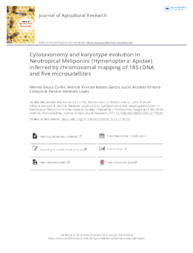Cytotaxonomy and karyotype evolution in Neotropical Meliponini (Hymenoptera: Apidae) inferred by chromosomal mapping of 18S rDNA and five microsatellites.
Cytotaxonomy and karyotype evolution in Neotropical Meliponini (Hymenoptera: Apidae) inferred by chromosomal mapping of 18S rDNA and five microsatellites.
Author(s): CUNHA, M. S.; GARCIA, M. V. B.; CAMPOS, L. A. O.; LOPES, D. M.
Summary: The Neotropical Meliponini bees, commonly known as stingless bees, are phylogenetically subdivided into three clades in which the chromosome numbers vary from n 1⁄4 8 to n 1⁄4 17. The goal of this study was to identify the major chromosomal rearrangements that occurred during the Neotropical Meliponini (Apidae) karyotypic evolution. In this way, we mapped 18S rDNA and five microsatellites in 33 stingless bee species collected from different Brazilian regions. The species belonged to 15 genera and showed six different chromosome numbers: n 1⁄4 8, n 1⁄4 9, n 1⁄4 11, n 1⁄4 14, n 1⁄4 15, and n 1⁄4 17. The 18S rDNA probe showed a variation from 2 to 12 marked chromosomes in different positions (terminal, subterminal, or centromeric), including 2 B chromosomes out of the 7 B found in Tetragonisca fiebrigi. The microsatellite (GA)15, (GAG)10, (CAA)10, and (TCAGG)6 probes formed clusters on the euchromatic regions of the chromosomes and were useful in the identification of putative Robertsonian fusion events that led to the decrease in the chromosome number during the evolution of the Neotropical Meliponini clade. (TTAGG)6 constituted the telomeric sequence of the analyzed species. The ancestral state of the three Neotropical Meliponini clades is difficult to infer, although, the putative ancestral karyotype probably had a single pair of 18S rDNA cistrons, and the decrease in chromosome number and increase in the 18S rDNA sites occurred independently between genera.
Publication year: 2023
Types of publication: Journal article
Unit: Embrapa Western Amazon
Observation
Some of Embrapa's publications are published as ePub files. To read them, use or download one of the following free software options to your computer or mobile device. Android: Google Play Books; IOS: iBooks; Windows and Linux: Calibre.
Access other publications
Access the Agricultural Research Database (BDPA) to consult Embrapa's full library collection and records.
Visit Embrapa Bookstore to purchase books and other publications sold by Embrapa.

